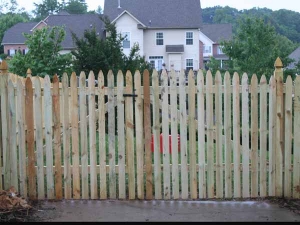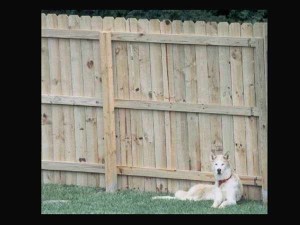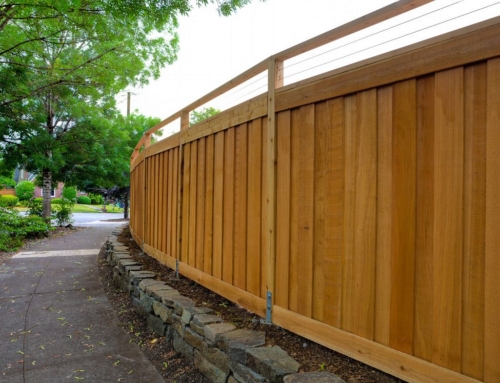Cedar Cypress Pine – Comparison of Wood Fencing
Cedar Cypress Pine – Natural Wood Fencing Materials
One of the most popular building materials for fencing today is natural wood lumber. Many subdivisions have outlawed the galvanized chain link fencing The lumber cedar cypress pine is readily harvestable and a naturally renewable resource! So what is the difference you keep hearing about the best lumber for fencing? That is a common question on sales calls so I want to take a few minutes to comment on it here.
Cedar Cypress Pine – Is it a good deal or a great deal?
Now, this is a great question and it depends on what part of the country you live in! The cedars (not to be confused with WESTERN RED CEDAR) cypress and fir products have a good lifespan in colder regions where the frost line is 3′ or more. You see when it gets that cold the insects will shut down and not feed on the fencing in the cold months.
Here in the South, we live in the Termite Belt, Tennessee, Georgia, Alabama, and Mississippi with perfect conditions for subterranean termite growth! Don’t believe me, just pick up the phone book or google termite pest control companies. The reason there are so many is that every home needs to be protected from nature’s clean-up crew.
That being said, if you live in the Termite Belt area, or if you have termite pest control treatments and termite bait traps, then you should probably mark the cedar and cypress off your list. Check out the photos above to see the damage done to those fences every year. We replace the cedar and cypress fences every week, normal life is about 7 years but can vary 5-10 years.
So is it a great deal to buy a fence twice in 10 years? I don’t think so, that is why we only use the treated pine lumber for natural wood fencing. Now, every lumber has good and bad points so to be fair about it….what is wrong with the pine lumber?
Pine lumber, a natural regional renewable resource is the #1 selling lumber for framing homes. It has been used for construction since before the 1900s and is proven as a quality low-cost building product. Newer technology in the late 1960s injected insecticide into this same plentiful lumber to produce the termite-resistant lumber. I compare the concept to roasted salted peanuts in the shell (how do they do that?). Raw peanuts are soaked in salt water, the saltwater gets inside the shell, when roasting the moisture is removed and the salt residue is left behind. The same concept applies to the pine pressure treatments, after treating the moisture is removed leaving the insecticide inside the cell structure of the lumber.
The characteristic of the pine to absorb moisture is the same characteristic that allows it to dry out resulting in warping. So you have the good and the bad, it is treated for termites and long life, also more susceptible than other lumber to warp. NOTE: All lumber is a natural product and thus made of cell structure and during extreme heat, ALL WOOD DRIES OUT AND WARPS TO SOME DEGREE! If anyone guarantees lumber against warpage…. too good to be true!
Cedar Cypress Pine – How Long Will It Look Like New?

Charleston Pine Picket Fence replaces old cedar fence
Here is another great question, how long before it loses that new look? I have been fencing for over 32 years and in my experience, all lumber exposed to direct full sunlight will take about a year to fade out. For a fence in the shade under trees, it may take a little longer …a year and a half give or take. What exactly is happening to the fence when it turns color? This is the ultraviolet sun rays bleaching out the top coating (or skin) of the fencing. If you were to take a picket off and crosscut the board you would find that the natural color of the wood is still there and only a thin layer has grayed out.
Cedar Cypress Pine – Fence Maintenance What to Expect!

Charleston Natural Wood Picket Fence
Pressure washing your fence can bring back its natural color… In about a year the sun will have done it again! What to do? Many homeowners will stain their fence a honey color for that new fence looks! DO NOT PAINT YOUR FENCE! Painting is a top coating on the lumber and will peel when exposed to the elements. Staining a fence is a method of having the stain soak into the actual wood fibers (sort of like mustard on a white t-shirt).
Stains and sealers were commonly confused years ago. Stains have color to soak in, while sealers do just that, seal the lumber to stop moisture. The lines of delineation between stains and sealers have closed and now most stains will have a sealer base in them.
Remember that a clear sealer does nothing about the sun’s damaging effects on your wood fence, so I recommend you use a color stain with a sealer base. Take scrap samples of your fence boards to test the colors. Stains will look different on different lumber, so run a test strip first.
Cedar Cypress Pine – Pricing of Natural Wood Fencing

Windsor Natural Wood Privacy Fence
The cedar mentioned here is NOT western red cedar, I call it “Knock off Cedar” because some fence companies will use the lower quality product in their bait and switch scams. The reason these companies use this product is that it is less expensive and most homeowners confuse the knockoff cedars with the real thing WESTERN RED CEDAR (which is much more expensive). Even the cypress board or swamp cypress board is less expensive than pine.
The knock-off cedars, fir, and cypress lumber all cost less than pressure-treated pine and in 12 months all the fencing will be turning a barn wood gray anyway so what is the BIG DIFFERENCE!
Subterranean termites! The south is infested with nature’s clean-up crew! Pressure-treated pine is the only material that is warranted for protection against termites! Think about it for a minute: All of the outdoor structures (decks, docks, gazebos, fences, arbors) are built with treated pine lumber, and for those using composites…the structural lumber is still treated pine!
A price range for installed treated pine picket fence is from $11.00 to $15.00 per foot with most of the fences falling between $12.00 – $14.00
The full-size privacy fence will range from $14.00 – $25.00 depending on styles and options with most coming in between $15-$20.000








